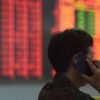Andrew Fox | The Symbol Reserve | Getty Photographs
“Dead” traders incessantly beat the residing — no less than, on the subject of funding returns.
A “dead” investor refers to an lazy dealer who adopts a “buy and hold” funding technique. This incessantly results in higher returns than energetic buying and selling, which in most cases incurs upper prices and taxes and stems from impulsive, emotional decision-making, professionals mentioned.
Doing not anything, it seems, in most cases surrenders higher effects for the typical investor than taking a extra energetic function in a single’s portfolio, in keeping with funding professionals.
The “biggest threat” to investor returns is human habits, now not govt coverage or corporate movements, mentioned Brad Klontz, an authorized monetary planner and monetary psychologist.
“It’s them selling [investments] when they’re in a panic state, and conversely, buying when they’re all excited,” mentioned Klontz, the managing major of YMW Advisors in Boulder, Colorado, and a member of CNBC’s Marketing consultant Council.
“We are our own worst enemy, and it’s why dead investors outperform the living,” he mentioned.
Why returns fall cut
Lifeless traders proceed to “own” their shares via ups and downs.
Traditionally, shares have all the time recovered later a downturn — and feature long past on to achieve unused heights each unmarried hour, Klontz mentioned.
Knowledge displays how adverse evil behavior may also be relative to the buy-and-hold investor.
The typical keep investor’s go back lagged the S&P 500 keep index by way of 5.5 share issues in 2023, in keeping with DALBAR, which conducts an annual investor habits study. (The typical investor earned about 21% time the S&P 500 returned 26%, DALBAR mentioned.)
The theme performs out over longer hour horizons, too.
The typical U.S. mutual charity and exchange-traded charity investor earned 6.3% in line with presen all through the last decade from 2014 to 2023, in keeping with Morningstar. On the other hand, the typical charity had a 7.3% general go back over that length, it discovered.
That hole is “significant,” wrote Jeffrey Ptak, managing director for Morningstar Analysis Services and products.
It approach traders misplaced out on about 15% of the returns their finances generated over 10 years, he wrote. That hole is in step with returns from previous classes, he mentioned.
“If you buy high and sell low, your return will lag the buy-and-hold return,” Ptak wrote. “That’s why your return fell short.”
Stressed out to run with the herd
Emotional impulses to promote all through downturns or purchase into sure divisions once they’re peaking (assume meme shares, crypto or gold) create sense when taking into consideration human evolution, professionals mentioned.
“We’re wired to actually run with the herd,” Klontz mentioned. “Our approach to investing is actually psychologically the absolute wrong way to invest, but we’re wired to do it that way.”
Marketplace strikes too can cause a fight-or-flight reaction, mentioned Barry Ritholtz, the chairman and leading funding officer of Ritholtz Wealth Control.
Extra from Non-public Finance:
Buyers might be ‘miles forward’ in the event that they steer clear of those 3 issues
Keep volatility poses an ‘alternative’
How traders can able their portfolios for a recession
“We evolved to survive and adapt on the savanna, and our intuition … wants us to make an immediate emotional response,” Ritholtz mentioned. “That immediate response never has a good outcome in the financial markets.”
Those behavioral errors can upload as much as main losses, professionals say.
Imagine a $10,000 funding within the S&P 500 from 2005 via 2024.
A buy-and-hold investor would have had nearly $72,000 on the finish of the ones twenty years, for a ten.4% reasonable annual go back, according to J.P. Morgan Asset Control. In the meantime, lacking the ten best possible days available in the market all through that length would have greater than halved the overall, to $33,000, it discovered. So, by way of lacking the most efficient 20 days, an investor would have simply $20,000.
Purchase-and-hold doesn’t cruel ‘do not anything’
After all, traders shouldn’t in fact do not anything.
Monetary advisors incessantly suggest unadorned steps like reviewing one’s asset allocation (making sure it aligns with funding horizon and targets) and periodically rebalancing to guard that blend of shares and bonds.
There are finances that may automate those duties for traders, like balanced finances and target-date finances.
Those “all-in-one” finances are extensively diverse and take charge of “mundane” duties like rebalancing, Ptak wrote. They require much less transacting on traders’ phase — and restricting transactions is a common key to good fortune, he mentioned.
“Less is more,” Ptak wrote.
(Mavens do deal some warning: Watch out about protecting such finances in non-retirement accounts for tax causes.)
Regimen additionally is helping, in keeping with Ptak. That suggests automating preserve and making an investment to the level imaginable, he wrote. Contributing to a 401(okay) plan is a superb instance, he mentioned, since employees create contributions every payroll length with out serious about it.
















